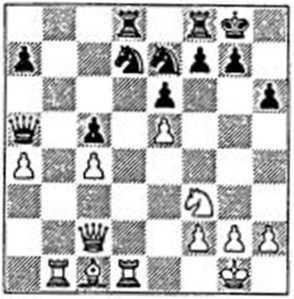
Opening Preparation
Mark Dvoretsky and Artur Yusupov
With contributions from:
Sergei Dolmatov
Yuri Razuvaev
Boris Zlotnik
Aleksei Kosikov
Vladimir Vulfson
Translated by Joint Sugden
В. T. Batsford Ltd, London
First published 1994
© Mark Dvoretsky. Artur Yusupov 1994 Reprinted 1994, 1996 ISBN 0 7134 7509 9
British Library Cataloguing-in-Publication Data. A CIP catalogue record for this book is available from the British Library.
Ail rights reserved. No part of this book may be reproduced, by any means, without prior permission of the publisher.
Typeset by John Nunn GM and printed in Great Britain by Redwood Books, Trowbridge, Wilts for the publishers, В. T. Batsford Ltd, 4 Fitzhardinge Street, London W1H0AH
A BATSFORD CHESS BOOK
Editorial Panel: Mark Dvoretsky, John Nunn, Jon Speclman
General Adviser: Raymond Keene OBE
Commissioning Editor: Graham Burgess
Forcing a draw by repetition.
Of course, given a little more time, the struggle could have been continued. For example, White could have set an attractive trap with 30 h3, hoping for 3O...We6?. There would follow 31 Sf6 Wd7 32 Дсб! «'c? 33 ■^xh6+! ФхЬб 34 £)f5+, and White gives mate. But I don’t advise you to be tempted by such traps in serious play; they arc not without dangers. After the correct 3O...43g8! (taking control of the f6 square) there would be some difficulties for White to overcome. As played, the duel ended in a draw at once.
The game we have just examined illustrates an important principle which I generally try to follow. Faced with an unexpected move in the opening, try not to give the opponent a psychological advantage on any account; search for active possibilities. strive for the initiative by any means. Only then can you count on solving your opening problems successfully.
The next example shows how you can strive for victory with an opening set-up which the opponent knows better than you.
Shirazi-Yusupov St John 1988 French Defence
1 e4 c6
2 d4 d5
3 ФсЗ ДЬ4
4 Фе2
An unpleasant surprise in (hat this system has a strong drawing tendency - and I aimed to play for the win. despite having Black.
4 ... de
5 a3 Дс7
6 Фхс4 ФГ6
7 Wd3 0-0
8 ДГ4 (38)
38 В

What candidate moves would you suggest here for Black? Let us take them in order. Number one: 7...Феб. Number two: 7„.b6. Number three: 7...&bd7. Number four - well, are there no other ideas? Then look what happened in the game.
8 ... £d5!?
It is a well-known principle that the same piece should not be moved twice in the opening. But in this case Black is pursuing a very specific aim. I won’t insist that my decision here was best. But it was combative - it forced my opponent to solve some concrete and none-too-simplc problems’ Moreover, strictly speaking, this move doesn’t lose all that much time. After all, White must now withdraw his bishop, otherwise Black simply exchanges it and acquires the advantage of the bishoppair.
9 Ad2
When playing 8...Ф<15 Black had to have some particular plan in view, for White clearly intends to drive the knight back with c2-c4. Then there will be nothing to justify the loss of time. But what exactly can Black undertake? The pawn sacrifice 9...b5 looked dubious to me. Of course it contains a positional idea - the attempt to control the light squares -but just now it is rather premature. What else is there?
9 ... b6
10 c4 Даб
Essentially, Black is just mystifying his opponent. I don't think that with an operation like ...Ф<15 and ...Даб you can achieve much. There arc several normal reactions for White. One is 11 b4, another is 11 £}2g3 followed by 'O'cl. Black would soon probably have to withdraw his knight to f6. after which White would have a comfortable game. Still, in so far as Black has done nothing truly reprehensible, his handling of the opening is basically just one possibility amongst many others.
Shirazi approached the position differently. He felt that his knight on c2 was already developed and that it was time to bring out his light-squared bishop.
11 g3
A move provoked by the position of the bishop on a6.
11 ... Ы7
12 £g2 (39)
Here again, I chose a combative solution. You may be asking what it was. It is not so simple to find.
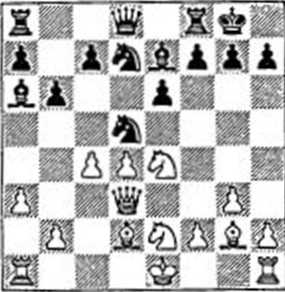
Let us consider the resources for both sides. In the first place, a worrying thought arises: what if White withdraws his queen to c2 next move? The knight will have to leave d5, and if I’m not careful I will even lose the exchange on a8.... This looks dangerous. I had been intending to move the rook to b8, but then I thought: ‘Suppose he does take my rook. After ...'S,xa8 perhaps 1*11 find some counterplay on the long diagonal.’
Another feature of the position is that if Black didn’t have a knight on d5, he could play ..ЛкГ7-е5, for the white queen is undefended! Is there some way Black can carry out this attractive tactical stroke?
Objectively, the move I played may be questionable, but in the final analysis it was thanks to this move that I won the game.
12 - 435Г6!?
Have a try at explaining the point of Black’s combination. After the seemingly forced line 13 £}xf6+ ДхГб 14 Дха8 #хз8 15 0-0, White is not threatened with anything - but the whole point is that this line is not forced! It is precisely in the intermediate blow 14...Фе5! that the idea of the combination lies.
13 Qxf6+ Axf6
14 Дха8
Of course Shirazi is not compelled to play this, but as I was hoping, he couldn’t resist the temptation to take the rook.
14 ... Фе5!
15 Wc4 #xa8
16 tfxa8 Qd3+
The decision to embark on this whole variation was extremely difficult. After all, the exchange is the exchange! But I studied it closely and concluded that Black does have compensation. The character of the game has abruptly changed and the initiative is on his side.
There arc certain particular cases where such risky play is justified. Shirazi has an active style; he likes to attack. Players of this type arc prone to underrate the opponent's threats and defend without too much assurance.
17 ФП 3xa8
18 ЬЗ ДЬ7
The immediate 18...c5 was also worth considering.
19 3gl c5! (40)
40 W
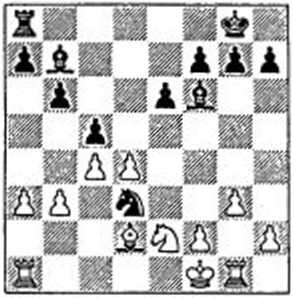
The light-square weakness in White’s camp and his somewhat backward development offer definite compensation for the exchange. I believe this compensation is sufficient, though I cannot say more than that. Black’s pieces arc active, he has the bishop pair, and in addition he has chances of picking up a pawn. All this put me in good spirits!
All the same, the position is far from clear. How it should all turn out is hard to say. If, for instance. White were now to play 20 ДсЗ, Black would hardly have anything better than 2O...Sd8, allowing the following line: 21 de £xc5 22 £xf6 gf 23 Фе1!? (but not 23 b4? Qb3). and if 23...£xb3, then 24 3d 1.
20 ДеЗ? Sd8
It seems that Shirazi had intended 21 3d 1, and only now saw the reply - that same 21...Фе5! again. Disconcerted by this turn of events, he lost his bearings and succumbed more or less without a fight.
|
21 |
&f4?! |
cd |
|
22 |
£xd3 |
de |
|
23 |
Фс2 |
cf |
|
24 |
£xf2 |
Дха1 |
The upshot is that Black simply has a sound extra pawn and the better
|
position. | ||
|
25 |
3xal |
f6 |
|
26 |
Scl |
ФП |
|
27 |
ФсЗ |
e5 |
|
28 |
a4 |
Феб |
|
29 |
aS |
f5 |
|
30 |
c5 |
be |
|
31 |
£d3 |
£d5 |
Realising the advantage is simple. Black simply pushes his kingsidc
|
pawns. | ||
|
32 |
Фхс5+ |
Фd6 |
|
33 |
b4 |
g5 |
|
34 |
Фаб |
f4+ |
|
35 |
ФГ2 |
e4 |
|
36 |
h4 |
h6 |
There is no need to work out any variations. Two connected passed pawns combined with the formidable bishop are quite enough to win the game.
|
37 |
£c7 |
Фс5 |
|
38 |
hg |
hg |
|
39 |
gf+ |
gf |
|
40 |
3c5 |
e3+ |
|
41 |
Фс2 |
Фе4 |
0-1
Let us ask what it was that ended Black to win so easily. He unc up against a system of dcvclop-ent that was unfamiliar to him. and tually this promises nothing good. । my view, the secret of Black’s suc-jss is largely bound up with his psy-lologically correct reaction to the jponent’s unexpected choice of xming. He didn’t allow himself to : drawn into any prepared vari-ions of a forcing nature, such as >uld arise (for instance) from 4 ic2 de 5 аЗ ДхсЗ+; he preferred an riginal scheme of development ith a well-defined positional basis. uch tactics - deflecting the appoint from his course, especially if he in a lower category - frequently roduce good results.
The next example continues the terne of the French Defence. The allowing game against A.Sokolov -as played in our Candidates Match, nd I remember that it gave me much reative satisfaction.
A .Sokolov-Yusupov Candidates Final (3), Riga 1986 French Defence
1 c4 сб
3 4te3
5 аЗ
Match chess has a quality of its wn; the opening contest occupies a special place in it. The aim of Black’s last move is obvious: he wants to exchange his bad ’French bishop*. In the first game, Sokolov preferred to avoid this exchange by playing 8 ДЬ5+ Jld7 9 £d3. He obtained quite a good position, but subsequently lost in a complex struggle. It was clear that for game three he would think up something new. But what? To be honest, my second and I did not succeed in guessing it during our preparation, so the opening of this game was to a certain extent unexpected to me.
8 a4
A typical move in such positions. 8 ... Даб
9 Дхаб
White more often plays 9 ДЬ5+.
9 ... Фхаб
10 0-0 2>b8
11 de
In practice 11 £jg5 and 11 ДаЗ have also been tried.
11 ... be
12 c4!(47)
White plays to undermine the centre.
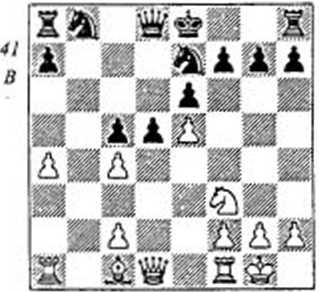
Now I had to have a serious think. I only had some vague recollections of the games in the Geller-Spassky Candidates quarter-final (Sukhumi 1968), where this variation had been seen a few times. In such situations you have to use your common sense, and if the position permift, steer away from well-trodden paths, selecting lines that arc positionally well founded but not so well studied.
I sensed that the further course of the struggle would in many ways depend on which squares the black knights went to - in particular, where the queen’s knight was developed.
12 ... 0-0
A move that arouses few doubts.
13 cd
But now it is time to deviate from the well-studied lines and not wail for Sokolov to spring some surprise on me. As far as I recall, Spassky took on d5 with his queen.
13 ... &xd5!?
Quite a good place for the knight. At the moment Black is scarcely afraid of c2-c4. since the knight can settle on b4.
14 «d3
What would you suggest for Black now?
To answer this question properly, you have to recognise the aim of White's last move. He intends, of course, to play 14 £ig5, forcing ...g7-g6 which suddenly weakens the dark squares. This weakening is very significant when you consider (hat
White’s dark-squared bishop has no opposite number.
14 ... h6
The position is very complicated. I was aiming to meet 15 2d I with 15...ЙС6, and if 16 ДаЗ, then 16...<?jcb4, leading to unclear play. Sokolov played more directly, but less soundly.
15 c4 (42)
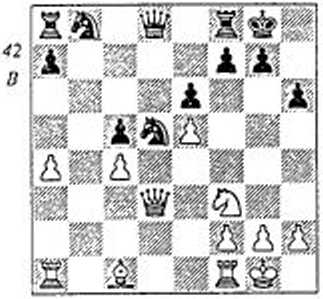
What are the possibilities for Black now? With the white pawn on a4, the move 15...£lb6 is clearly uninviting. The knight would also be badly placed on c7. The choice is between 15...£)b4 and 15...£jc7.
I rejected 15...£)b4 on the basis that after 16 ^04 <S)8c6 17 ДеЗ my knights would be in an awkward position. The one on b4 superficially looks active, but that is all. In reply to 17...'^e7, White would strengthen his position with 18 Sadi! (the right rook) I8...Sfd8 19 Sd6, and if I9...Sxd6 then 20 Дхс5, emerging with an extra pawn.
On reflection I decided that the right place for the knight was e7.
Here it can be useful in defence of the kingside and generally has good prospects. In some lines it can move to f5 and then d4; or else it can go to g6 to attack the pawn on e5. Of course, in selecting this move, I also had to assess some concrete variations - for example the following, which seems fairly dangerous to Black: 15...2kc7 16 Edl <xd3 17 E.xd3 £lbc6 18 ДеЗ, and the pawn on c5 looks indefensible. But in fact it is not! I had prepared the reply I8...Sfc8!, and if 19 Дхс5 then 19...£ixe5!. This may be called the tactical justification of 15...'Sic?.
In this case we observe how a general appraisal of the situation is linked to concrete analysis. This is generally a prerequisite for taking the right decision. You can adduce all manner of general considerations in support of a move, but if it afterwards turns out that in one variation you simply lose a pawn, all your arguments will lose their point. It is vital to support your judgements with exact calculation!
15 ... £c7!
16 We4
Now the important question is where to develop the queen’s knight - on c6 or d7. After some thought, I opted for 16...£d7, since after 16...£>bc6 the defence of the c5 pawn would be much more complicated. In general, when facing an unexpected system, it is essential to give increased attention to your opponent’s threats.
16 ... £d7
17 Ebl?
The best continuation was 17 Edl. But I saw that after 17...'£Zc7 there was no need to fear 18 Ed6?l in view of 18...4У5!» when 19 Zc6? is bad: 19...«Ъ7 20 Ebl £sb6, with the deadly threat of 21...Sac8.
Sokolov's move was superficial. He understood that I would have met 17 Edl with 17...’й'с7, and decided to forestall that move by preparing the reply 18 Sb7. Yet 17...Ш is by no means obligatory. Black can now achieve easy equality with 17...Eb8. But at this moment I sensed that my position was already superior and that I could very well play for the win.
17 ... Wa5!
If you have the opportunity for an active move, take it! Black now seizes the initiative. The white pawn on a4 is en prise. White should definitely have admitted his mistake and returned his rook to al.
18 Edl
Why didn’t I simply lake the pawn? At first sight Black is not threatened with anything.
In fact, though, 18...Wxa4? can be met by 19£xh6!gh 20Ealtfc621 Wxc6 £xc6 22 Sxd7, and White has everything in order. Black is counting on something better.
18 ... Ead8!
The alternative 18...ФЬ6 was not bad cither, but 18...Ead8 seemed to me the most energetic decision (not, however. 18...Efd8? 19 Sxd7!). As long as While’s bishop is still on lhe back rank, his king cannot fed secure. It has no ’loophole’, and tactical threats are already in Lhe air.
19 Wc2 (43)
Sokolov decides to protect his a-pawn, and misses the striking rejoinder. It is amusing that just as in the previous game, a knight sonic from d7 to c5 seals White’s fate!
43 в

19 ... &xc5!l
20 £xe5
20 Exd8 ?kf3+.
20 ... Wc3!
No doubt about it, such moves arc pleasant to play.
21 We2 WxeS
22 ДеЗ £f5
As a result of the combination Black has gained a pawn and clearly has a winning position. But he still has to overcome a few technical difficulties.
23 Wf3 Exdl+
Perhaps the immediate 23...&d4 was preferable, but I decided to play more simply.
24 Exdl 4id4
Sokolov now made a serious mistake. He should have played 25 <b7. Then Black would most likely have had nothing better than 25...Фс2 26 <13 ФхеЗ, with an ending in which White keeps some saving chances.